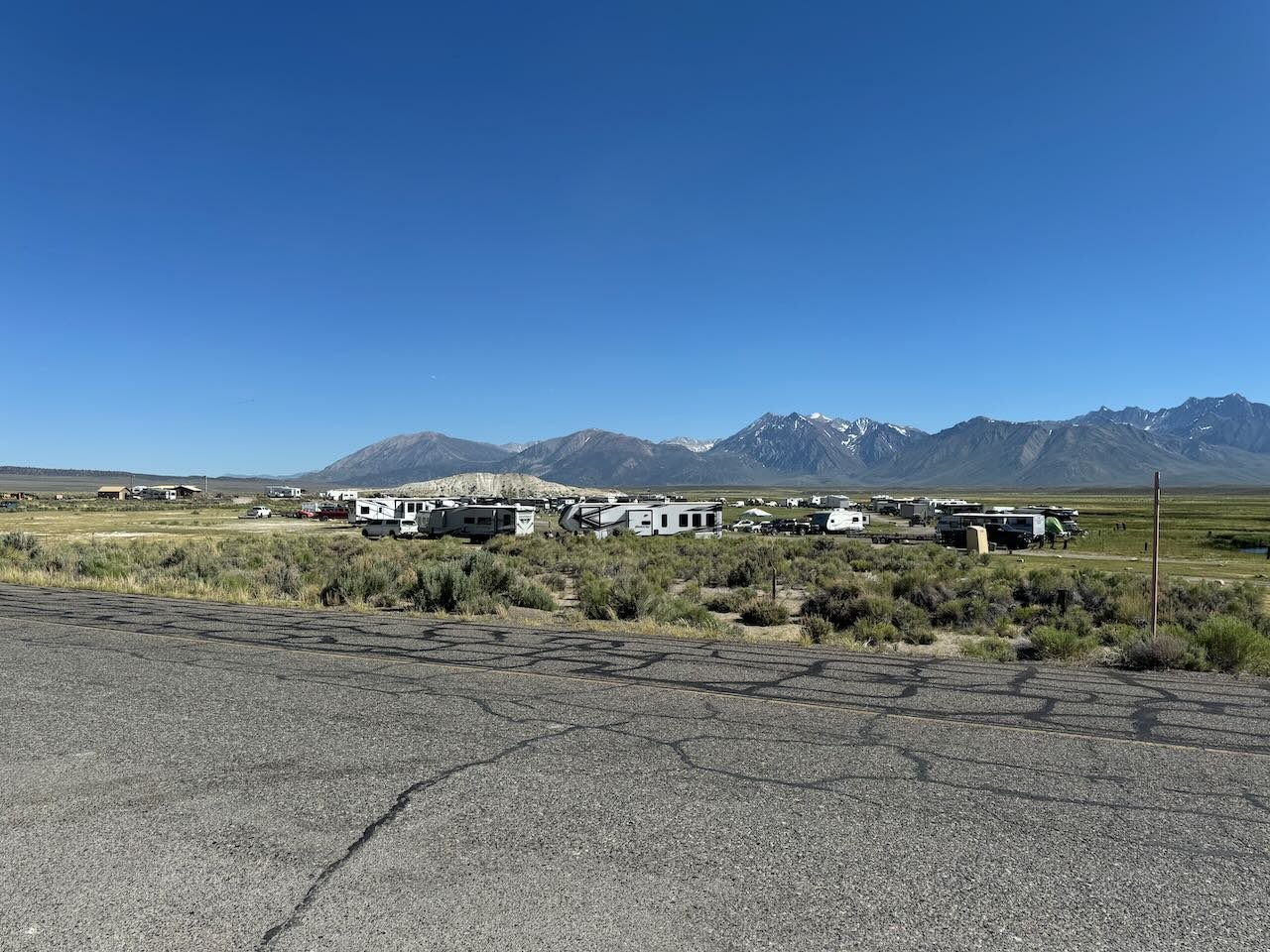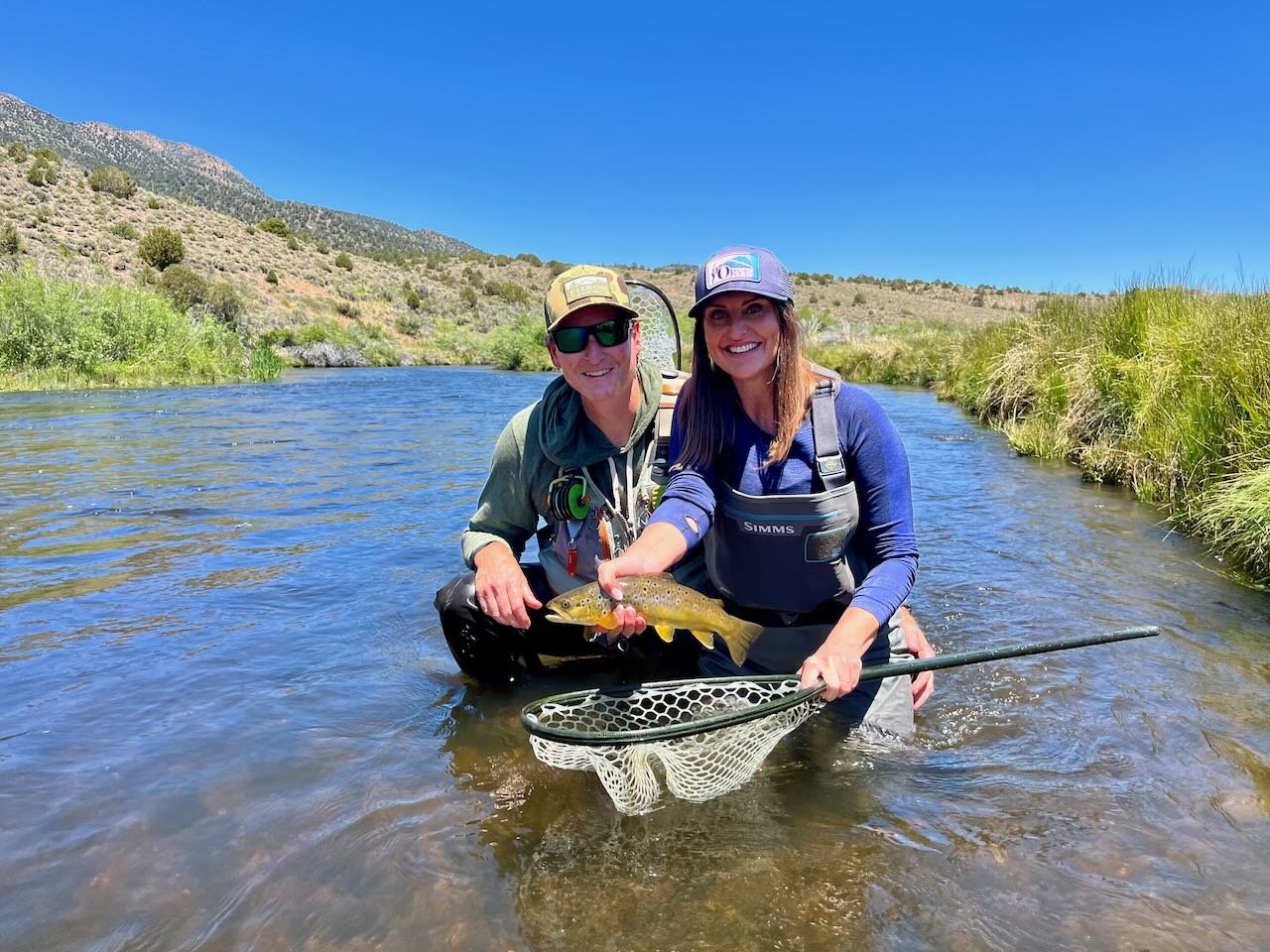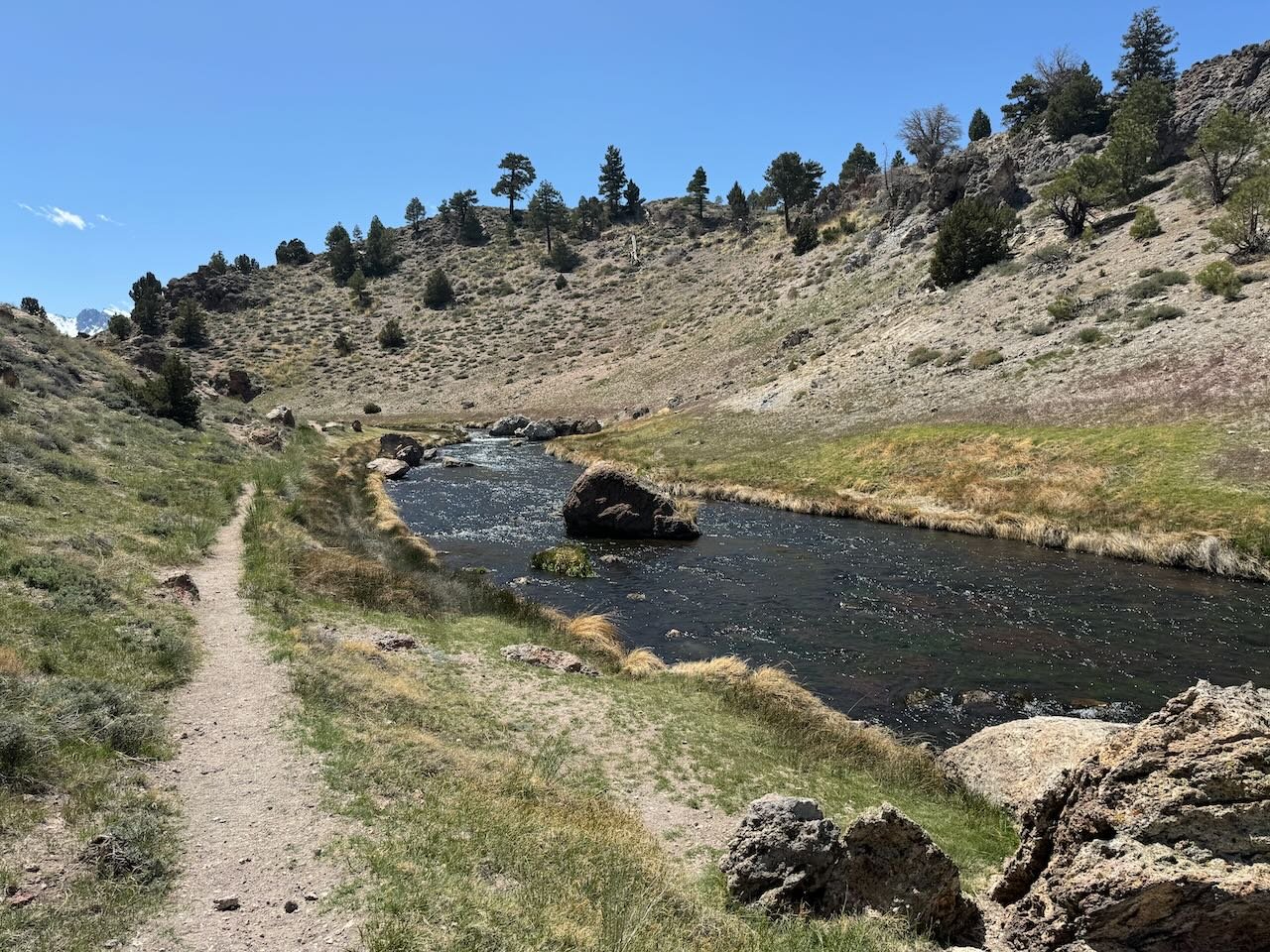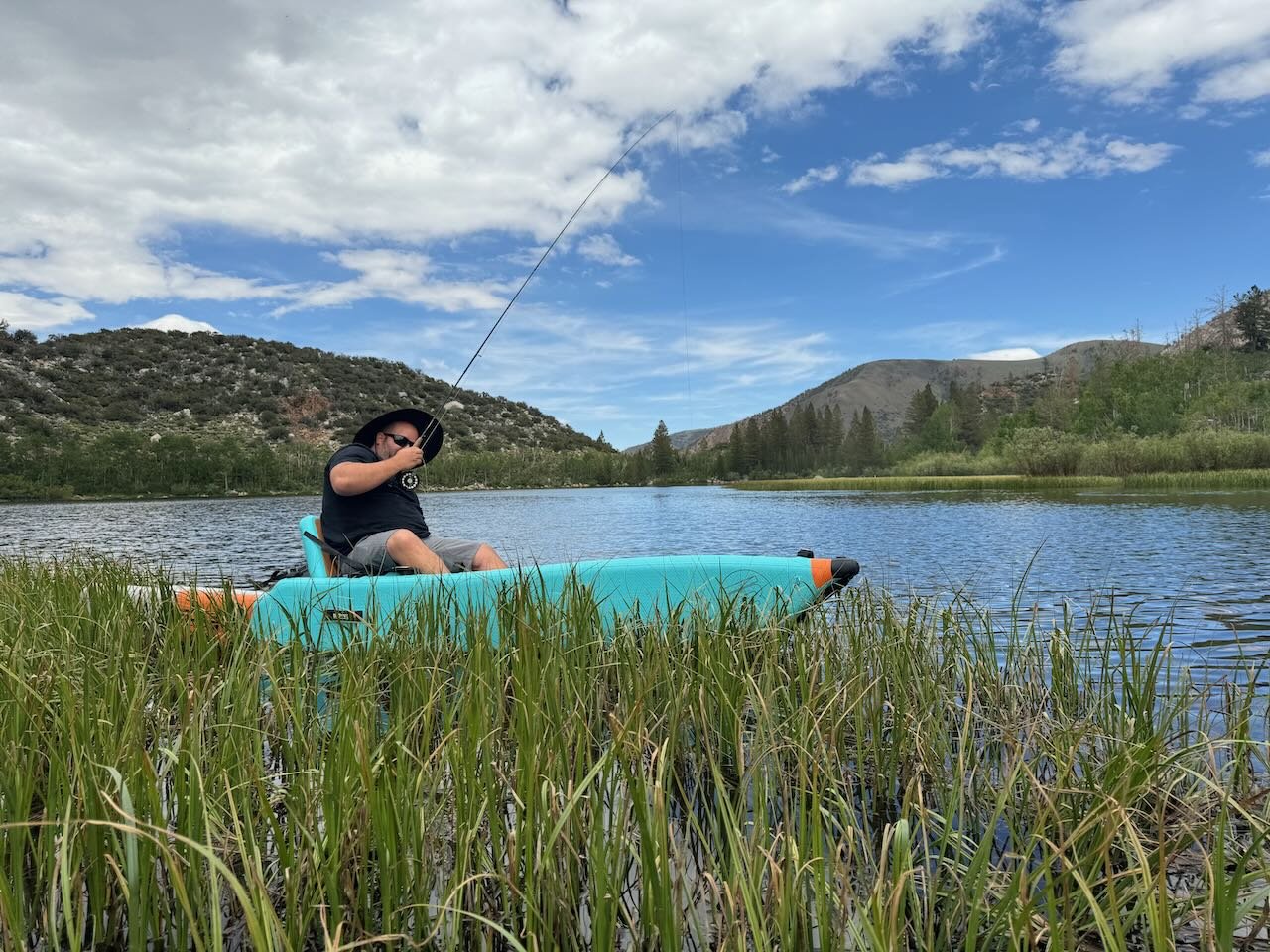Hatching insects, warm days, mosquitoes and feeding fish makes fly fishing the Eastern Sierra the place to be. Summer time is the time to camp and fly fish on the waters of the Eastern Sierra. Hatching mayflies, caddis flies, stone flies and midges is fueling the trout’s ravaging appetite. Dry flies, nymphs and streamers are fooling the trout. Still waters, streams and backcountry waters are the places to be fly fishing right now. High elevation lakes are just starting to ice out and offering the opportunity to fish for trophy trout.
Summer time is camping and fly fishing on the waters of the Eastern Sierra like camping at Browns on the River Campground and fly fishing on the upper Owens River.
East Walker River
Below Bridgeport:
The Miracle Mile section of the East Walker River continues to produce trout for fly fishers nymphing and dry fly fishing. Hatching caddis and mayflies continue to provide the stimulus for the feeding wild brown trout and rainbow trout. Nymphing under an indicator or with a Euro rig with size 18 olive quilldigons, size 16 hot spot pheasant tail nymphs, size 12 stoner nymphs, size 16 tungsten Duracell’s, size 18 bead head flash back pheasant tail nymphs and size 16 bead head flash back gold ribbed hare’s ears are fooling the trout feeding on nymphs. On the surface fish with size 16 elk hair caddis, size 16 E/C caddis, size 18 Adams parachutes, size 18 blue wing olive parachutes and size 18 olive sparkle duns. Pulling streamers can produce some of the biggest fish of the day.
Shannon and Brian Chastain with a nymph caught brown trout from the Miracle Mile section of the East Walker River.
Hot Creek
Interpretive Site:
Consistent dry fly activity makes fly fishing the interpretive site with dry flies the most productive method to fly fish the creek. Hatches of pale morning dun mayflies, blue wing olive mayflies and gray caddis are the insects the trout are feeding on off the surface of the creek. Size 16 pale morning dun parachutes, size 16 pale morning dun sparkle duns, size 20 blue wing olive parachutes, size 20 blue wing olive sparkle duns, size 20 gray parachute caddis and size 20 gray elk hair caddis are the dry flies that are fooling the surface feeding trout.
Water condition in Hot Creek Canyon are perfect for nymphing under an indicator or with a Euro rig.
Hot Creek
Canyon Section:
In the right sections the trout are feeding on the surface on hatching mayflies, caddis flies and stoneflies. Nymphing continues to be the productive method of fly fishing the canyon section of the creek with a dry and dropper rig or under an indicator. Size 12 stoner nymphs, size 16 bead head flash back gold ribbed hare’s ear nymphs, size 18 bead head flash back pheasant tail nymphs, and size 20 gray La Fontaine’s sparkle caddis are the nymphs the trout are taking on the substrate of the creek. The hatches start around 9 in the morning and are over by early afternoon.
Sandy Point Pond is back and there is no lake bed vehicle access as the lake is all the way up to the sage brush at Sandy Point.
Crowley Lake
North Landing:
Crowley Lake is the place to be in Southern Mono County on the Fourth of July to enjoy the fireworks. The North Landing Road continues to be closed due to flooding of the roads along the north arm of Crowley Lake and in the area of Sandy Point. Tentative opening date for North Landing Road is after the Fourth of July. Maybe on the 5th of July. Float tubers and boaters are hooking up on rainbows, browns and cutthroat trout in Hilton Bay with midges suspended above the mud bottom of the lake. Tiger midges, zebra midges, blood midges, gray midges and albino midges in size 16 or 18 are fooling the trout feeding on the midge pupae. The midge pupae are slowly ascending to the surface of the lake to hatch in to the adult stage of the midge. As the midges progress up the water column the fly fishers need to move their flies up the water column. Start the morning with your midges three to 12 inches above the mud bottom of the lake. Finish the morning with your flies at four to five feet above the substrate of the lake.
Rainbow and brown trout are consistently taking nymphs and dry flies all day on the upper Owens River.
Upper Owens River
Above Benton Crossing Bridge:
Fly fishing on the upper Owens River has been great for six to 20 inch wild browns and rainbows. These trout are taking dries and nymphs. On the surface fish with size 16 brown elk hair caddis, size 18 blue wing olive parachutes, size 16 pale morning dun parachutes and size 16 Adams parachutes. Nymphing with size 18 bead head flash back pheasant tail nymphs, size 16 bead head flash back gold ribbed hare’s ears nymphs, size 18 olive quilldigons and size 16 hot spot pheasant tail nymphs. The trophy trout are taking the nymphs and the six to 12 inch juvenile trout are taking nymphs and the dry flies. Success on the upper Owens River is thoroughly covering the water making sure your flies float by all the trout holding waters. Pale morning dun hatch is been in the early afternoon. It’s mosquito season and fly fishers need to be prepared by carrying insect repellant.Bishop Creek Canyon
A dry and dropper rig produced lots of wild rainbow and brown trout for Jamie Metzger from Woodland Hills on the waters of North Lake.
Bishop Creek Canyon
North Lake:
North Lake is a quantity fishery for fly fishers. Using a dry and dropper rig is producing lots of five to 10 inch wild brown and rainbow trout. For the dry fly use a size 14 olive stimulator, size 14 Adams parachute, size 14 olive elk hair caddis and a size 12 mini Chernobyl ant. For the nymph use a size 18 bead head flash back pheasant tail nymph, size 16 bead head flash back gold ribbed hare’s ear, size 18 or 20 tiger midges and zebra midges. A float tube or other water craft gives the fly fisher complete access to the shore line. Wading fly fishers will find lots of feeding trout at the inlet to North Lake. Size 12 olive wooly buggers stripped or trolled behind the float tube is fooling trout and in particular the bigger stocked rainbows. Bishop Creek Canal
Euro nymphing in the morning with a stoner nymph, olive quilldigon and a hot spot pheasant tail nymph is producing wild brown trout and stocked rainbow trout.
Bishop Creek Canal
Behind Bishop Veterinary Hospital:
It’s that time of the year that the Owens Valley is heating up. With temperatures in the high 90’s to low 100’s it’s hot fly fishing on the canal middle of the day. Best fly fishing is early or late in the day. Fishing in the evening from when the sun goes behind the Eastern Sierra tell dark is a great time to be skittering a size 16 elk hair caddis. The caddis are ovipositing in the evening and the trout are responding feeding on the female caddis laying their eggs.







